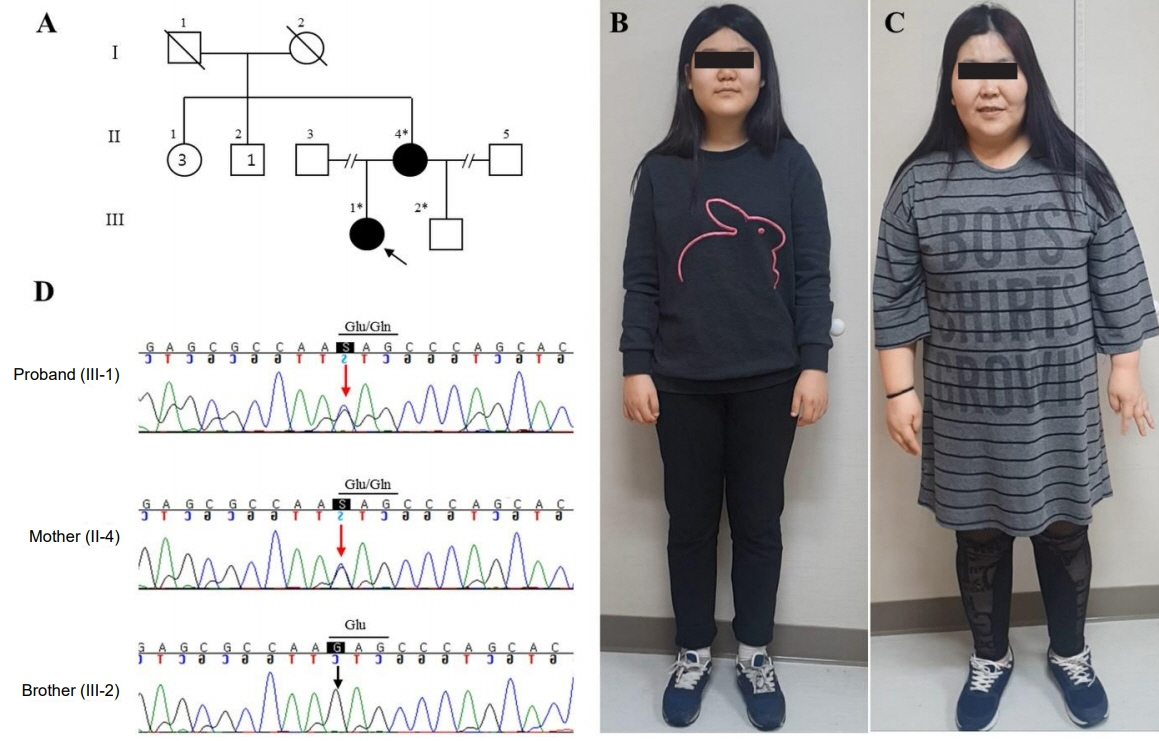Ann Pediatr Endocrinol Metab.
2019 Dec;24(4):253-256. 10.6065/apem.2019.24.4.253.
First identified Korean family with Tatton-Brown-Rahman Syndrome caused by the novel DNMT3A variant c.118G>C p.(Glu40Gln)
- Affiliations
-
- 1Department of Pediatrics, Nowon Eulji Medical Center, Eulji University, Seoul, Korea. pedseo@eulji.ac.kr
- 2GC Genome, Yongin, Korea.
- KMID: 2468728
- DOI: http://doi.org/10.6065/apem.2019.24.4.253
Abstract
- Tatton-Brown-Rahman Syndrome (TBRS), an overgrowth syndrome caused by heterozygous mutation of DNMT3A, first was described in 2014. Approximately 60 DNMT3A variants, including 32 missense variants, have been reported, with most missense mutations located on the DNMT3A functional domains. Autosomal dominant inheritance by germ-line mutation of DNMT3A has been reported, but vertical transmission within a family is extremely rare. Herein, we report the first Korean family with maternally inherited TBRS due to the novel heterozygous DNMT3A variant c.118G>C p.(Glu40Gln), located outside the main functional domain and identified by multigene panel sequencing. The patient and her mother had typical clinical features, including tall stature during childhood, macrocephaly, intellectual disability, and characteristic facial appearance. TBRS shows milder dysmorphic features than other overgrowth syndromes, potentially leading to underdiagnosis and underestimated prevalence; thus, targeted multigene panel sequencing including DNMT3A will be a useful tool in cases of overgrowth and unexplained mild intellectual disability for early diagnosis and genetic counseling.
Keyword
MeSH Terms
Figure
Reference
-
References
1. Tatton-Brown K, Seal S, Ruark E, Harmer J, Ramsay E, Del Vecchio Duarte S, et al. Mutations in the DNA methyltransferase gene DNMT3A cause an overgrowth syndrome with intellectual disability. Nat Genet. 2014; 46:385–8.
Article2. Xin B, Cruz Marino T, Szekely J, Leblanc J, Cechner K, Sency V, et al. Novel DNMT3A germline mutations are associated with inherited Tatton-Brown-Rahman syndrome. Clin Genet. 2017; 91:623–8.3. Tlemsani C, Luscan A, Leulliot N, Bieth E, Afenjar A, Baujat G, et al. SETD2 and DNMT3A screen in the Sotos-like syndrome French cohort. J Med Genet. 2016; 53:743–51.
Article4. Evers C, Staufner C, Granzow M, Paramasivam N, Hinderhofer K, Kaufmann L, et al. Impact of clinical exomes in neurodevelopmental and neurometabolic disorders. Mol Genet Metab. 2017; 121:297–307.
Article5. Kosaki R, Terashima H, Kubota M, Kosaki K. Acute myeloid leukemia-associated DNMT3A p.Arg882His mutation in a patient with Tatton-Brown-Rahman overgrowth syndrome as a constitutional mutation. Am J Med Genet A. 2017; 173:250–3.6. Lemire G, Gauthier J, Soucy JF, Delrue MA. A case of familial transmission of the newly described DNMT3AOvergrowth Syndrome. Am J Med Genet A. 2017; 173:1887–90.7. Okamoto N, Toribe Y, Shimojima K, Yamamoto T. Tatton-Brown-Rahman syndrome due to 2p23 microdeletion. Am J Med Genet A. 2016; 170A:1339–42.8. Shen W, Heeley JM, Carlston CM, Acuna-Hidalgo R, Nillesen WM, Dent KM, et al. The spectrum of DNMT3A variants in Tatton-Brown-Rahman syndrome overlaps with that in hematologic malignancies. Am J Med Genet A. 2017; 173:3022–8.9. Tatton-Brown K, Zachariou A, Loveday C, Renwick A, Mahamdallie S, Aksglaede L, et al. The Tatton-Brown-Rahman Syndrome: a clinical study of 55 individuals with de novo constitutive DNMT3A variants. Wellcome Open Res. 2018; 3:46.
Article10. Yang L, Rau R, Goodell MA. DNMT3A in haematological malignancies. Nat Rev Cancer. 2015; 15:152–65.
Article11. Richards S, Aziz N, Bale S, Bick D, Das S, Gastier-Foster J, et al. Standards and guidelines for the interpretation of sequence variants: a joint consensus recommendation of the American College of Medical Genetics and Genomics and the Association for Molecular Pathology. Genet Med. 2015; 17:405–24.
Article12. Tatton-Brown K, Loveday C, Yost S, Clarke M, Ramsay E, Zachariou A, et al. Mutations in epigenetic regulation genes are a major cause of overgrowth with intellectual disability. Am J Hum Genet. 2017; 100:725–36.
Article
- Full Text Links
- Actions
-
Cited
- CITED
-
- Close
- Share
- Similar articles
-
- Tatton-Brown-Rahman Syndrome: A Report of a Case with a Novel DNMT3A Mutation Presented Hemihypertrophy
- Three Cases of Acquired Simulated Brown Syndrome after Blowout Fracture Operations
- Typical and A typical Brown's Syndrome
- Brown-Sequard Syndrome due to Herniated Cervical Disc
- The First Korean Case of Gorlin?Goltz Syndrome Caused by a PTCH2 Pathogenic Variant Identified via Whole Exome Sequencing


